

What to Do Now That You’ve Trapped a Nuisance Wild Animal
Cory Farnsworth and Nicki Frey, Ph.D.
Nusiance Wildlife
Many homeowners experience negative interactions with wildlife once they have become a pest or a nuisance. Utah State University (USU) Extension can help homeowners modify their homes and landscapes to avoid many negative interactions; however, sometimes, to resolve the conflict, the animal must be trapped (Figure 1.). Always check local laws and regulations before setting a trap. While most homeowners can legally trap nuisance animals, some species require special permits and licenses to trap; you may need to notify the Utah Division of Wildlife Resources (UDWR) before taking any action. For more in-depth information on trapping regulations in Utah, please refer to the current UDWR’s Furbearer Guidebook (UDWR, 2023)
Relocation and Translocation
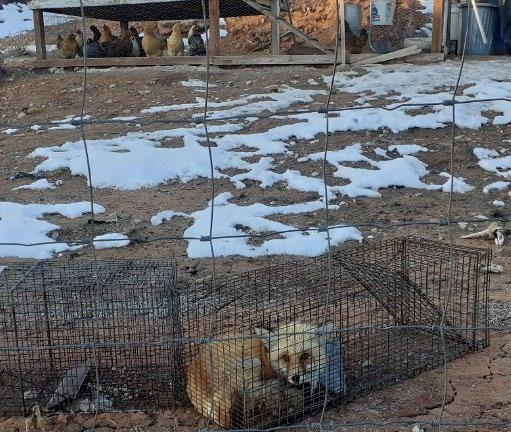
Once an animal is caught, many people have a difficult time killing it and believe that the best solution is to relocate it to a new home. Before relocating an animal, check the local laws and regulations. In this article, translocation and relocation are used interchangeably but refer to trapping an animal and moving and releasing it to another location any distance from the original location.
Relocation in Utah Is Illegal
To maintain agricultural production at the highest possible level and, at the same time, promote, protect, and preserve the state’s wildlife resources, the Utah Agriculture and Wildlife Damage Prevention Board has listed the field mouse, [pocket] gopher, ground squirrel, jack rabbit, raccoon, prairie dog, and skunk as depredating animals, and the coyote as a predatory animal (Utah Legislature, 2017). As such, they may be trapped and killed to protect agriculture and livestock production. These animals do not require a license or permit to hunt or trap. Additionally, Administrative Rule R657-3b states that a person may [trap] and kill coyotes, field mice, [pocket] gophers, ground squirrels, jackrabbits, muskrats, and raccoons at any time without a license. The red fox and striped skunk are also included as species not requiring a license or permit (UDWR, 2023). This can get confusing because if one is keeping the fur (pelt) of an animal also listed as a furbearer, a furbearer license or
Figure 1. A red fox that had been eating chickens.
trapping permit must be acquired. For example, spotted skunks are listed as furbearers but can also be killed year-round as nuisance wildlife. However, if one wants to save the spotted skunk’s pelt, one must register that activity before lethal control of the species and follow the limitations of that permit. While prairie dogs are considered nuisance wildlife, in Southern Utah, the Utah prairie dog is a federally threatened species and may not be trapped or harmed in any way (Figure 2)
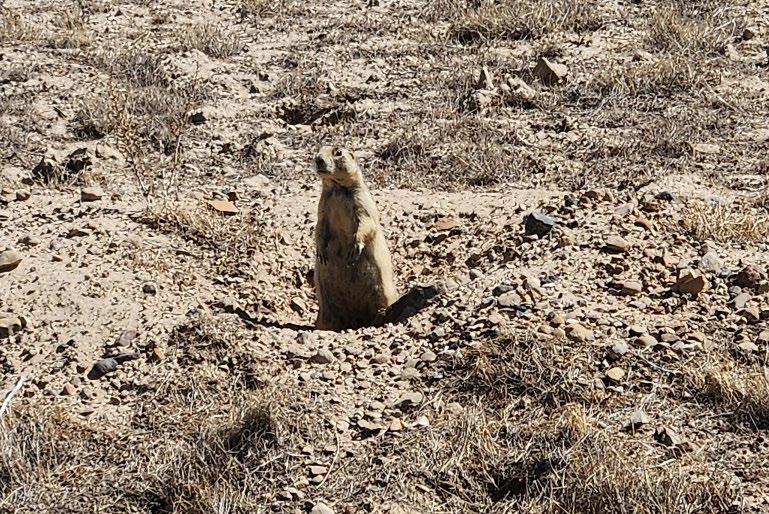
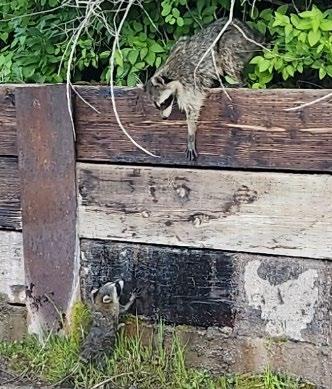
3. Raccoons, although cute, are non-native to Utah, can be detrimental to native wildlife, and must not be relocated.
Often, landowners, particularly those in urban and suburban communities, will live-trap nuisance animals on their property rather than use lethal techniques. Most nuisance animals that homeowners may consider live-trapping in Utah include ground squirrels, pocket gophers, prairie dogs, raccoons (Figure 3), skunks, and fox squirrels Once a homeowner has trapped one of these animals, how do they get rid of it?
Relocation Is Not a Best Management Practice
In Utah, it is illegal to transport any prohibited or controlled species of bird or mammal except as otherwise listed in table 3b-1 of Administrative rule R657-3b. Transport means to move or cause to move any animal within Utah by any means. Essentially, this means that none of the species commonly live-trapped may be transported off the residential owner’s property.
Prohibited and controlled species, if taken from the wild, introduced into the wild, or held in captivity pose or threaten to pose a significant detrimental impact to wild populations, the environment, or human health or safety (State of Utah, 2023) Transporting or possessing any of these species may lead to a citation, resulting in a Class B misdemeanor
Moving an animal away from its home territory can be stressful for the animal, and low survival rates of translocated animals are often reported (Julien et al., 2010). Some relocated animals find their way back within days. Most relocated animals become problems for someone else. Once an animal has become a nuisance and been caught, it can be much more difficult to catch it again if necessary. Some animals, like raccoons and opossums, are non-native and invasive species in Utah and can be detrimental to native species and the ecosystem in the relocation area. Transporting animals may also be a means of transporting disease or noxious weed seeds found in their fur.
Figure
Figure 2. The Gunnison prairie dog in southeastern Utah is not federally threatened like the Utah prairie dog.
The U.S. Department of Agriculture’s (USDA) Wildlife Services (WS) program and other wildlife professionals state that translocating wild mammals is not a biologically sound practice. Several national and international veterinary associations including the American Veterinary Medical Association (AVMA), the National Association of State Public Health Veterinarians, and the Council of State and Territorial Epidemiologists, oppose wildlife translocation because of disease risks (Mengak, 2018). Any live animal found in a trapping device must be euthanized and removed from the device by the trapper or released unharmed (UDWR, 2023).
Exceptions
There are some species for which it is acceptable to relocate. Usually, these are animals that can be a nuisance but have a conservation status. Only licensed practitioners with a permit from UDWR or the U.S. Fish and Wildlife Service can trap and relocate these animals. Threatened or endangered species and wildlife deemed beneficial to the ecosystem may be relocated by wildlife officials. For example, the Utah prairie dog is a federally threatened species. However, homeowners with Utah prairie dogs causing problems on their land can contact the UDWR to have them removed. They will be relocated onto protected public land.
Beavers are another example of a species that may cause a nuisance to homeowners (Figures 4 and 5) but have a positive benefit to the ecosystem. UDWR officials may trap nuisance beavers and relocate them to areas that need beavers to restore riparian (river) ecosystems (UDWR, 2017). For an animal to qualify for translocation, contact wildlife officials before trapping the animal.
For assistance in translocating protected animals that are becoming a nuisance, such as beavers and Utah prairie dogs, contact your regional UDWR office:
• Northern Region: 801-476-2740
• Northeastern Region: 435-781-9453
• Central Region: 801-491-5678
• Southeastern Region: 435-613-3700
• Southern Region: 435-865-6100
Dispatching or Euthanizing
Once you have trapped an animal that can’t be relocated, the other options are to open the cage and release it where it was caught, or to lethally control it (i.e., kill, dispatch, euthanize; Figure 6). When it is necessary to kill an animal, always select the most practical management method that is safe, effective, and considerate of the animal and the public. We strongly recommend methods of euthanasia humane methods to kill an animal. However, many of the

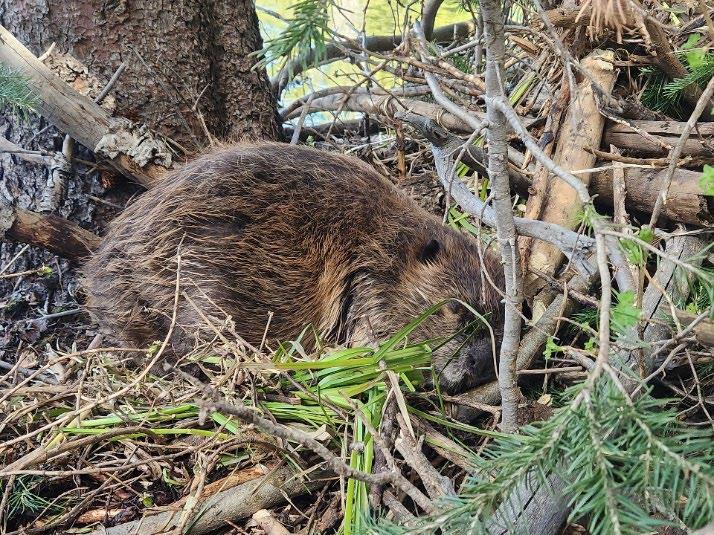
Figure 5. A beaver sleeps on a bank; so much for being busy!
Figure 4. A culvert plugged by a beaver causes problems for a local farmer.
recommended means of euthanasia for captive animals are not feasible for wild or feral animals (Julien et al., 2010)
To help manage wildlife (Figure 7), the Utah Department of Agriculture and Food has created a manual of control methods for many nuisance wildlife species, including euthanasia methods for each species that are approved by the American Veterinary Medical Association (Wierda et al., 2023). Individuals should use their best judgment for each situation.
When dispatching an animal, do so in private so as not to offend others. Recognize that there are cultural and generational differences that view many “traditional” methods of killing as unacceptable. Also, remember that methods that seem logical in rural settings may not be acceptable in suburban and urban settings. Following the AVMA Guidelines for Euthanasia is recommended; however, many substances and tools listed in these guidelines are only available to licensed professionals or pertain to domestic animals. While licensed professionals, such as veterinarians and animal control services, are required to abide by these standards of euthanasia, homeowners are instead subject to local ordinances.
In most cases, shooting the captured animal in the head is a quick and humane method for dispatching a trapped nuisance animal. In most cities and municipalities, using firearms is restricted; one would need to transport the animal outside of these areas to kill the animal in this way.
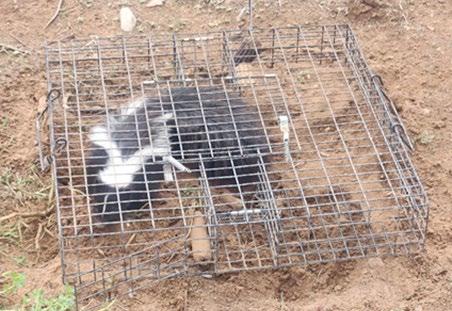
6. Skunks will usually spray when shot or alarmed, so many choose to call a professional when dispatching skunks.
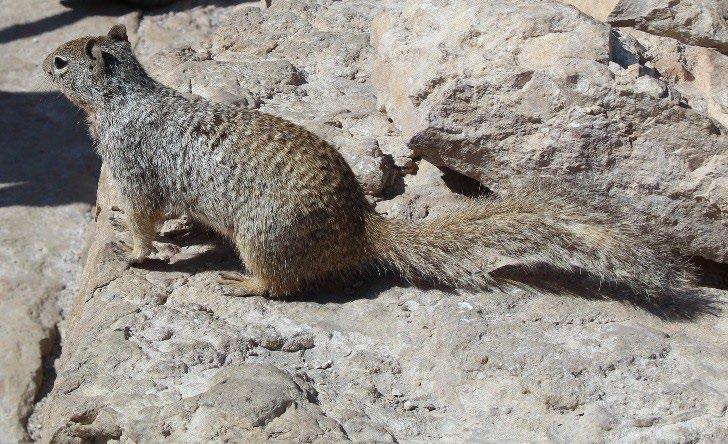
Other humane methods available to homeowners are cervical dislocation, and stunning followed by decapitation (Wierda et al., 2023). Drowning is not considered to be a form of euthanasia due to the time it takes for the animal to perish (Ludders et al., 1999).
Inhalants such as carbon monoxide and carbon dioxide are considered humane forms of euthanasia only when multiple conditions are employed to meet the qualifications of euthanasia. The AVMA (2020) recommends:
• Using a chamber to contain the animal and the carbon monoxide.
• Using a chamber that allows one to see the animal in the chamber.
• Regulating carbon monoxide to allow for a 6% saturation rapidly and consistently.
• Using carbon monoxide from a regulated source that is compliant with state and federal regulations, not from a combustion source (e.g., engine exhaust).
• Locating the chamber outside in a well-ventilated area.
If you cannot legally or humanely dispatch the animal, you may call someone authorized to deal with urban wildlife nuisance animals. In some municipalities, Animal Control officers will respond to such incidents. Some localities do not have that option, and individuals will need to call a private professional, often called a
Figure 7. Utah Rock Squirrel
Figure
“nuisance wildlife control officer ” You can find a current list of licensed nuisance control professionals (wildlife rehabilitators) on the UDWR website.
In some cases of depredation (such as a wild predator attacking livestock), the Utah Department of Agriculture and Food Predator Control Program may assist with predator control for those living outside of city limits. If you know a licensed trapper, they may be willing to help with a nuisance animal during trapping season.
Alternatives to Live Traps
Because of the difficulty of finding a suitable method to kill animals caught in a live trap, many residents may choose other options to manage nuisance wildlife.
Kill Traps
Due to the unique circumstances of each individual, live trapping may not be an option when the need to dispatch an animal occurs. In some locations, a kill trap may be a better option than a live trap (Figure 8). The proper size of the kill trap should be used depending on the size of the target animal. Catching a nontarget animal, such as a dog or cat, in a kill trap is possible, so use extreme caution when taking this route. USU Extension offers species-specific information and guidance on setting traps for smaller species such as rats and mice, and a trusted source for fur-bearing animals (larger mammals) is the Association of Fish and Wildlife Agencies’ “Furbearer Management and Best Practices for Trapping.”
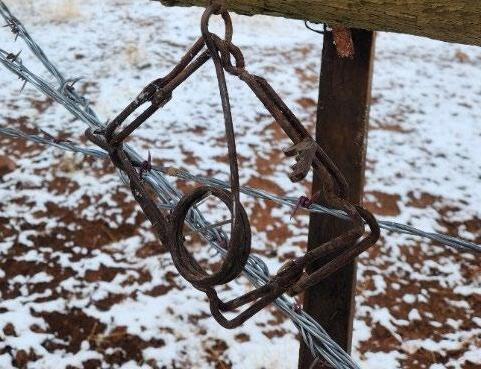
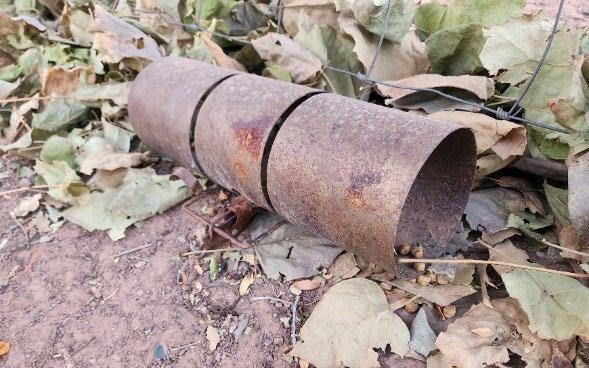
Figure 8. A conibear trap (left) and a tube trap (right). Both traps are designed to kill by striking the top and bottom of the animal simultaneously.
Poison
Rats, mice, and voles are often managed using poisons in a very controlled setting, such as a bait delivery station. However, there are very few options of poisons available for use in managing other vertebrates due to the nonselective nature of poisons (poisons often are lethal to more than just one animal species). If using a poison, only use the poison as authorized according to the label. If the target species is not listed on the label, do not use that poison. Most poisons are not advisable for use around homes.
Using the Animal
Some animal parts may be used for purposes such as fur or meat. Before using parts of an animal, understand local laws and regulations. Some species require that the animal be surrendered to the UDWR. From the late fall to early spring, some animals, such as raccoons, skunks, and other furbearers, grow a thick fur pelt. You can use this pelt in clothing, decoration, or education when skinned and tanned (Figure 9). Using the pelt or parts of an animal classified as a furbearer (such as a fox, bobcat, or beaver) often requires a permit or furbearer license. Contact your regional UDWR to determine if you require a permit before using parts from a nuisance animal. This season is optimal for trapping to avoid catching young offspring.
Most nuisance animals in Utah are not commonly considered for consumption; however, many people in other areas eat raccoons, ground squirrels, and fox squirrels. Individuals who eat nuisance animals do so at their own risk. Care should be taken to ensure the animal is not sick.
Although they may appear healthy, wild animals often carry parasites that can make humans very sick. Omnivores and carnivores such as raccoons, ground squirrels, foxes, etc., may contain parasites, such as trichinella, which need to be cooked to an internal temperature as high as 171 degrees to kill the parasites (trichinellosis). Raccoons carry roundworms that can cause blindness in humans (baylisascariasis). Mishandling wildlife can lead to several illnesses, including salmonellosis, Lyme disease, tularemia, leptospirosis, ringworm, bubonic plague, scabies, and rabies (Figure 10).
In most cases, we recommend disposing of the animal; this is for human and pet safety and does not constitute waste.
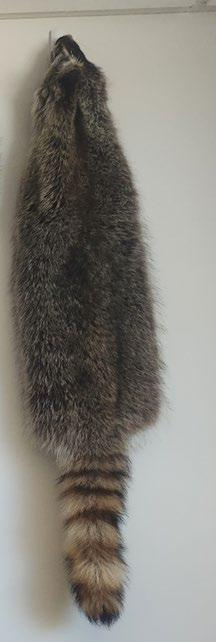
for Educational Purposes
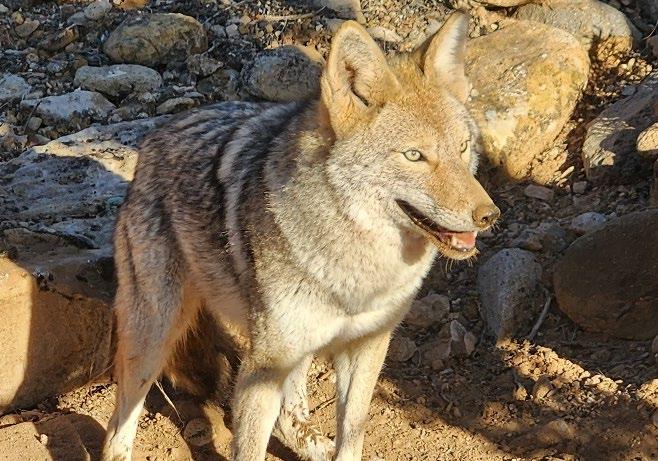
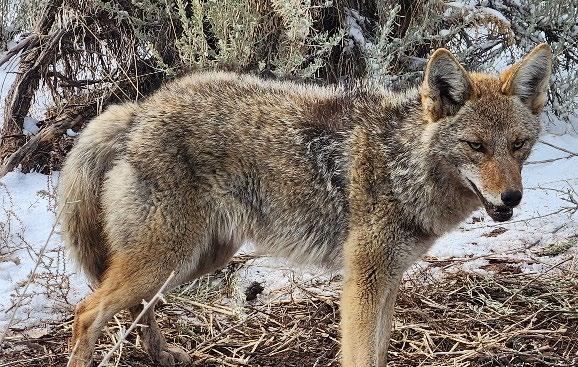
10. A healthy coyote (left) and a coyote with mange and possible other health issues (right). Notice the sparsity of fur near the shoulders and the coyote’s droopy, tired eyes (right).
Figure 9. Raccoon Pelt Used
Figure
Carcass Disposal
Safe Handling
Wear plastic gloves to protect against possible disease when handling a carcass. Consider wearing a mask to prevent against airborne disease. Wear long pants and sleeves, and be mindful of ticks, fleas, and bodily fluids, as these are other potential vectors of disease.
Dispose of carcasses properly to protect public sensitivities, environment, and public health (Vantassel & King, 2018). In Utah, wildlife can be buried, incinerated, or transported to a local landfill that accepts animal carcasses (see Utah Administration Code R657-40-9)
Burial
To dispose of a carcass by burial, the carcass should be covered by 12 to 24 inches of soil and should not come into contact with surface or ground water. A safe distance from ground-water sources is at least 200 feet (Vantassel & King, 2018). Animals should be buried in an area that will not be disturbed by pets or children.
Incineration
Carcasses may not be simply burned, such as in an outdoor fire pit, because emissions could be toxic or transmit diseases. There are technologies approved and used by local authorities to safely incinerate carcasses; these methods may not be cost-effective for the traditional homeowner. Incineration cannot be used for animals that have died from most toxicants.
Landfill
For small mammals, placing them in one or two heavy duty trash bags will suffice, and placing them in municipal trash bins may be acceptable. Most city and county waste services will properly dispose of carcasses in the landfill. You may check with your local landfill to understand their policy on carcasses. It is recommended that carcasses be disposed of as soon as possible.
Leave-Lay
Depending on your area, you may also leave carcasses lying in the field (UDWR, 2023). This is not recommended for most homeowners in urban or suburban communities or where other people or pets may find the carcasses. It should not be considered for animals suspected of diseases or dispatched with toxicants. If pets ingest animals that died from toxicants, they may also get sick and possibly die.
Composting
Using dead animals as part of composting is a method that is popular for returning nutrients to the soil. This method requires an area of land that will not be disturbed by children or pets. For most homeowners in urban or suburban communities, composting carcasses is not ideal because it results in strong, unpleasant odors and may attract more nuisance animals. Effective composting is a complicated process; for more information on composting carcasses, see Vantassel and King (2018)
Image Credit
Authors provided all figure images.
References
American Veterinary Medical Association (AVMA). (2020) AVMA guidelines for the euthanasia of animals. https://www.avma.org/sites/default/files/2020-02/Guidelines-on-Euthanasia-2020.pdf.
Andrews, E. J., Bennett, B. T., Clark, J. D., Houpt, K. A. P., Pascoe, J., Robinson, G. W., & Boyce, J. R. (1993). Report of the American Veterinary Medical Association panel on euthanasia. Journal of the American Veterinary Medical Association, 202, 229–249.
Julien, T. J., Vantassel, S. M., Groepper, S. R., & Hygnstrom, S. E. (2010). Euthanasia methods in field settings for wildlife damage management. Human-wildlife Interactions, 4, 158–164.
Ludders, J. W., Schmidt, R. H., Dein, F. J., & Klein, P. N. (1999) Drowning is not euthanasia Wildlife Society Bulletin, 27, 666–670.
Mengak, M. T. (2018). Wildlife translocation. Wildlife Damage Management Technical Series, Animal & Plant Health Inspection Service (APHIS), U.S. Department of Agriculture (USDA) Wildlife Services. https://www.aphis.usda.gov/sites/default/files/Wildlife-Translocation-WDM-Technical-Series.pdf.
State of Utah. (2023) Administrative rule R657-3a. https://wildlife.utah.gov/r657-3a.html
Utah Division of Wildlife Resources (UDWR). (2017). Utah beaver management plan. https://wildlife.utah.gov/pdf/furbearer/beaver_plan_2010-2020.pdf.
Utah Division of Wildlife Resources (UDWR). (2023). Utah Division of Wildlife Resources furbearer guidebook. https://wildlife.utah.gov/guidebooks/furbearer_guidebook.pdf
Utah Legislature. (2017, July 1). Chapter 23 agricultural and wildlife damage prevention act. https://le.utah.gov/xcode/Title4/Chapter23/C4-23_2017050920170701.pdf
Vantassel, S. M., & King, M. A. (2018, July). Wildlife carcass disposal. Wildlife Damage Management Technical Series, APHIS, USDA Wildlife Services www.aphis.usda.gov/sites/default/files/Carcass-Disposal-WDMTechnical-Series.pdf
Wierda, M. R., Frey, S. N., Price, S., & Tegt, J. (2023). Vertebrate animal pest control study guide. Utah Department of Agriculture and Food and Utah State University Extension. https://ag.utah.gov/wpcontent/uploads/2023/12/Vertebrate-Manual.pdf.
In its programs and activities, including in admissions and employment, Utah State University does not discriminate or tolerate discrimination, including harassment, based on race, color, religion, sex, national origin, age, genetic information, sexual orientation, gender identity or expression, disability, status as a protected veteran, or any other status protected by University policy, Title IX, or any other federal, state, or local law. Utah State University is an equal opportunity employer and does not discriminate or tolerate discrimination including harassment in employment including in hiring, promotion, transfer, or termination based on race, color, religion, sex, national origin, age, genetic information, sexual orientation, gender identity or expression, disability, status as a protected veteran, or any other status protected by University policy or any other federal, state, or local law. Utah State University does not discriminate in its housing offerings and will treat all persons fairly and equally without regard to race, color, religion, sex, familial status, disability, national origin, source of income, sexual orientation, or gender identity. Additionally, the University endeavors to provide reasonable accommodations when necessary and to ensure equal access to qualified persons with disabilities. The following office has been designated to handle inquiries regarding the application of Title IX and its implementing regulations and/or USU’s non-discrimination policies: The Office of Equity in Distance Education, Room 400, Logan, Utah, titleix@usu.edu, 435-797-1266. For further information regarding non-discrimination, please visit equity.usu.edu, or contact: U.S. Department of Education, Office of Assistant Secretary for Civil Rights, 800-421-3481, ocr@ed.gov or U.S. Department of Education, Denver Regional Office, 303-844-5695 ocr.denver@ed.gov. Issued in furtherance of Cooperative Extension work, acts of May 8 and June 30, 1914, in cooperation with the U.S. Department of Agriculture, Kenneth L. White, Vice President for Extension and Agriculture, Utah State University. July 2024 Utah State University Extension
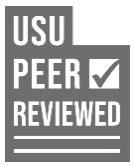
February 2025
Utah State University Extension
Peer-reviewed fact sheet
